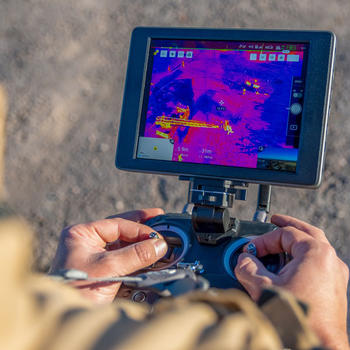A team of firefighters ascend the stairs in a high-rise engulfed in flames. The team disperses to put out the fire and search for survivors. Drones hover around the burning building and identify with pinpoint accuracy the location of each firefighter, who is wearing a sensor, sending this information back to a commander who has an “eye in the sky” vantage point.
The commander communicates with the firefighters, directing their movements, keeping them safe, and helping them extinguish the flames. If one member of the team hasn’t moved in several minutes, the system sends an alert to check on that person’s status.

You can imagine this scenario in a big-budget movie, but Vijay Shah, an assistant professor in the Cyber Security Engineering Department in the College of Engineering and Computing at George Mason University is working to make it a reality. If all goes well, firefighters will have a new, important tool like this within five years.
Funded by the National Institute of Standards and Technology, Shah is collaborating with colleagues at Virginia Tech and the Arlington, Virginia, County Fire Department on a 5G Indoor Positioning System that may someday be used by fire departments nationwide. Firefighters in Arlington will be testing the technology in a facility starting in 2025.
Advances in 5G network technology allow for this research because compared to other legacy wireless communications, 5G provides much greater accuracy and does not rely on equipment within the building, which may be damaged during a fire. A key development Shah and colleagues are exploiting is called “network slicing,” sending certain pieces of information over portions of the 5G network.
“The critical information, such as location of the firefighter, is sent in one ‘slice’ and in a much smaller packet, allowing for virtually no delay in information relay," says Shah. "Transmitting audio/video information requires more data, but any information lost there simply reduces the quality of the audio/video, which is not as important as losing someone’s location. That information would be put in another slice.”
Shah notes that 5G has key capabilities, such as support for various timing and angle-based techniques, device-to-device communication, and edge computing, which can be leveraged to locate users precisely and enable reliable communication infrastructure. Together this allows for much greater situational awareness of firefighters—and victims—by knowing their precise location and allowing for seamless communication among the firefighting team.
The drones add another level of complexity, and at least three will be needed around a building to guarantee high levels of accuracy. The team is working to ensure drone communications are synchronized precisely, as even delays as short as milliseconds may result in improper readings. Shah says that getting the independently flying drones synced up is one of the project’s biggest challenges.
In This Story
Related News
- October 21, 2025
- October 1, 2025
- September 26, 2025
- March 27, 2025
- March 17, 2025
